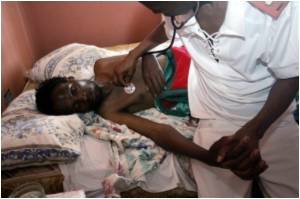Tuberculosis together with HIV infections in adults is the leading cause of death in Africa. Tuberculosis is a deadly infectious disease caused by the tuberculosis bacteria which affects the lung and other parts of the body. Most infections are inactive and without any symptoms in the beginning but can progress to an active tubercular disease which can be fatal if left untreated.
AIDS or acquired immune deficiency syndrome, as the name suggests, is an infection caused by the virus HIV (human immunodeficiency virus). The AIDS virus attacks the body’s immune system causing a breakdown of the body’s protective force. This can cause serious life-threatening opportunistic infections.HIV viruses infect the most important immune cells of the body known as the white blood cells, with a special affinity for the T helper cells. The T-helper lymphocytes are responsible for fighting infections and maintaining the body immunity. The T-cells which have a cluster of glycoproteins known as CD4 are specifically targeted and eventually destroyed. As a rule, CD4 cell count decreases as the HIV virus infection increases. A CD4 cell count helps doctors to determine the HIV infection state of the patient and determines the treatment. The normal CD4 cell count ranges between 500-1500 cells per cubic millimeter of blood while a low count may depict AIDS.
Preventive therapy is imperative to prevent the progression of inactive tuberculosis to an active case in patients who are already immunocompromised with HIV infection. The developing and underdeveloped world is still sadly lacking in the provision of preventive treatment for tuberculosis in spite of the World Health Organization’s strong recommendations. Routinely, isoniazid is given for six months to patients to avert TB. However, most public health programs which resolve to avert the symptomatic development of tuberculosis fail because of low completion rates, re-infection of tuberculosis and drug resistance.
A recent comparative clinical study was conducted in Soweto, South Africa by Richard Chaisson, MD and his associates from the Johns Hopkins Medical Institute in Baltimore, Maryland. This study was done to observe three different new tuberculosis prevention treatments as apposed to the standard regimen of isoniazid for a period of 6 months.
1148 adult patients with a positive tuberculin skin test without signs of active tuberculosis were randomly selected. These patients were at an average age of 30 years and had a median CD4 cell count of 484 per cubic millimeter.
The results of the study indicate that there was no remarkable difference in the incidence of development of active tuberculosis or death between any of the three groups treated with newer drug regimens and those taking isoniazid alone daily for 6 months (the control group). However, there were grave unfavorable adverse effects observed with patients taking continuous isoniazid daily for 6 years. Other serious adverse effects were also seen in the groups with newer drug regimens but to a lesser extent. These results show that these newer prophylactic or preventive medication regimens against tuberculosis in a HIV infected adult or even the use of continuous isoniazid for 6 years do not show better or more superior results compared to those taking isoniazid alone for only 6 months.
Source-Medindia















